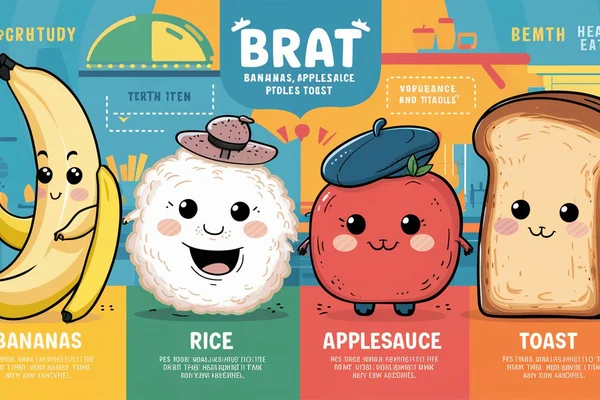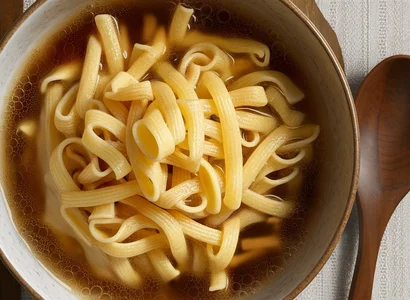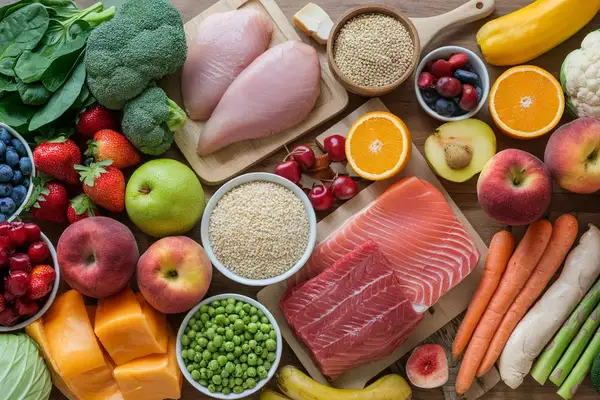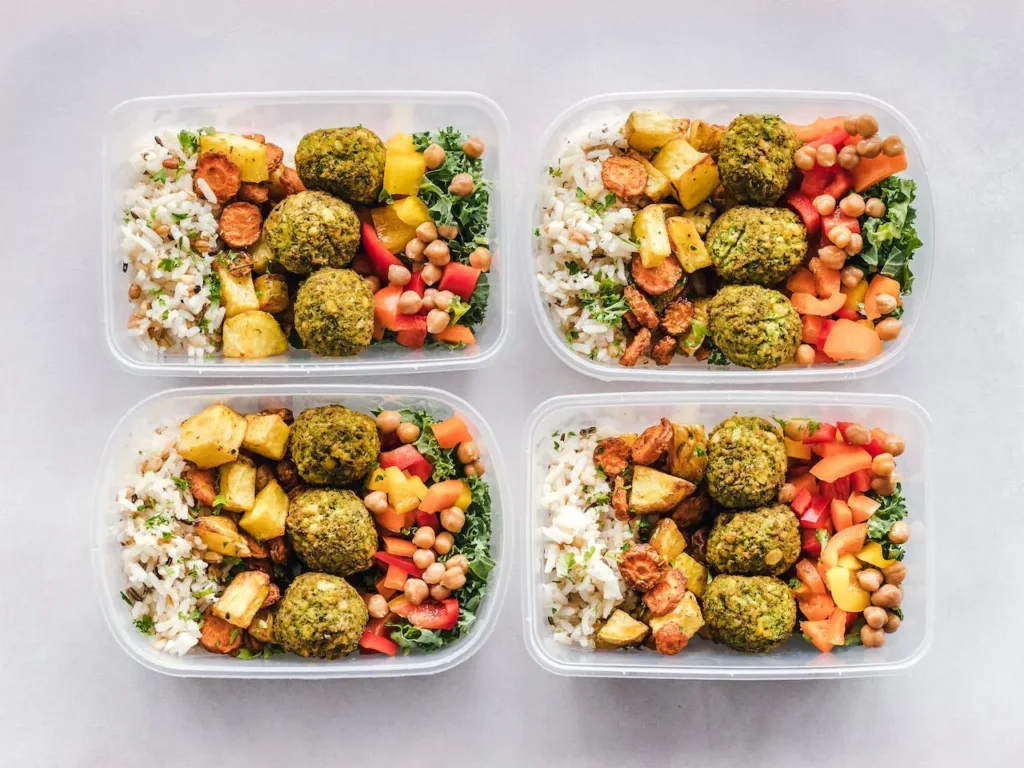BRAT Diet: Foods to Eat and Avoid for Gastro Issues

This post may contain affiliate links, meaning I may earn a commission if you make a purchase, at no extra cost to you. I only recommend products I trust. Thank you for your support.
When you’re dealing with an upset stomach, finding the right foods to eat can be a challenge. That’s where the BRAT diet, a specific type of bland diet comes in handy.
The BRAT diet is a short‑term bland food regimen traditionally recommended for people, especially children experiencing acute gastrointestinal upset such as diarrhea, vomiting, or stomach flu.
The core BRAT diet is very restrictive and should only be followed for a short period (typically 24-48 hours).
In this article, we’ll explore what the BRAT diet is all about, which bland foods you should eat and avoid, its benefits, and some concerns to keep in mind.
We’ll also look at how this bland diet can be adapted for adults and provide some simple BRAT diet recipes to help you get started.
What is the BRAT Diet?
The BRAT diet is a dietary regimen often recommended for people recovering from gastrointestinal issues, particularly those experiencing nausea, vomiting, or diarrhea.
The term “BRAT” first appeared in medical literature in 1926. It’s a clever acronym that stands for the four main components of the diet:
B – Bananas
R – Rice (white)
A – Applesauce
T – Toast (plain)
This diet is designed to be gentle on the stomach and provide easily digestible foods that can help firm up stools and reduce nausea.
Here are some key points about the BRAT diet:
- Purpose: It’s primarily used as a short-term solution to help settle the stomach and provide some nutrients while recovering from stomach upset.
- Low-fiber content: The foods in this diet are low in fiber, which makes them easier to digest and less likely to irritate the gastrointestinal tract.
- Bland foods: These foods are relatively bland, which can help reduce nausea and the risk of further irritating the stomach.
- Electrolyte balance: Bananas, in particular, can help replace potassium and other electrolytes that may be lost due to diarrhea or vomiting.
- Limited use: The BRAT diet is not meant to be followed for an extended period as it doesn’t provide a complete range of nutrients.
- Hydration: It’s crucial to stay hydrated while on this diet, especially if recovering from diarrhea or vomiting.
When to use the BRAT diet
You might consider using the BRAT diet when you’re experiencing:
- Nausea
- Vomiting
- Diarrhea
- General stomach upset
BRAT Diet Meal Plan (BRAT Diet for Diarrhea)
This BRAT diet for diarrhea is tailored for adults, offering simple, bland, and easily digestible foods that soothe the stomach and intestines. This diet plan is divided into two phases: Phase 1 (Initial Phase) and Phase 2 (Intermediate Phase).

Initial Phase (Phase 1)
Breakfast:
- Plain Toast: Toast a slice of white bread until lightly golden. (1 slice white bread)
- Mashed Banana: Peel and mash half a ripe banana. (1/2 ripe banana)
Lunch:
- White Rice: Cook white rice in water. (1/2 cup uncooked white rice, 1 cup water)
- Applesauce: Serve unsweetened applesauce. (1/4 cup unsweetened applesauce)
Dinner:
- Plain Toast: Toast a slice of white bread until lightly golden. (1 slice white bread)
- White Rice: Reheat cooked white rice. (1/2 cup cooked white rice)

Intermediate Phase (Phase 2)
Breakfast:
- Toast with Applesauce Spread: Toast a slice of white bread and spread a small amount of applesauce. (1 slice white bread, 1 tbsp unsweetened applesauce)
- Banana: Peel and eat a ripe banana. (1 ripe banana)
Lunch:
- Plain Pasta with Chicken Broth: Cook plain pasta in water and add a little chicken broth. (1/2 cup uncooked pasta, 1 cup water, 1/4 cup chicken broth)
Dinner:
- Boiled Potatoes: Boil potatoes until soft. (1 medium potato, water for boiling)
- Applesauce: Serve unsweetened applesauce. (1/4 cup unsweetened applesauce)
BRAT Diet Food List
When you’re dealing with stomach issues, the BRAT diet offers a selection of foods that are gentle on your digestive system.
Here are the BRAT diet foods to eat.
1. Bananas
Bananas are a key element of the BRAT diet. They’re easy to digest and can help firm up your stool. Here’s why bananas are beneficial:
- Rich in pectin, a starch that’s good for your digestive tract
- Help replace potassium lost due to vomiting or diarrhea
- Green banana pulp can help reduce diarrhea in children
However, keep in mind that ripe bananas are high in FODMAPs, which might cause discomfort for some people. If you experience bloating or gas, try eating half a banana instead of a whole one.
2. Rice
Rice is another staple of the BRAT diet. It’s gentle on your stomach and can help reduce the duration of diarrhea. Here’s what you need to know:
- White rice is preferred as it’s lower in fiber
- Rice-based oral rehydration solutions can help reduce stool volume
- Rice soup has been found effective in treating acute diarrhea in children
3. Applesauce
Applesauce is a safer alternative to whole apples when you’re experiencing stomach issues. Here’s why it’s recommended:
- Rich in pectin, which can help treat diarrhea
- Easier to digest than whole apples
- Provides nutrients without the risk of vomiting associated with apple peels
4. Toast
Toast is the final component of the BRAT acronym. It’s a simple, bland food that’s easy on your stomach. Opt for plain white bread toast as it’s lower in fiber and easy to digest.
5. Other Recommended Foods
Besides the BRAT foods, you can include other bland, easy-to-digest options:
- Clear broths (chicken or vegetable)
- Crackers
- Cooked cereals (oatmeal, cream of wheat)
- Weak tea
- Apple juice or flat soda
- Boiled or baked potatoes (without added butter or cream)
- Steamed, baked, or grilled skinless chicken
- Watermelon
- Canned peaches and pears
Foods to Avoid on the BRAT Diet
When you’re following the BRAT diet, it’s crucial to know which foods to steer clear of. These foods can potentially irritate your digestive system and slow down your recovery.
Let’s take a closer look at what you should avoid while on the BRAT diet.
1. High-fiber Foods
These foods contain insoluble fiber, which can be hard on your stomach when it’s already upset:
- Raw vegetables such as parsnips, beets, corn on the cob, and members of the cabbage family
- Salad greens, carrot sticks, broccoli, and cauliflower
- Legumes like beans and lentils
- Seeds and whole grains
- Citrus fruits like pineapples, oranges, and grapefruits
- Other fruits such as cherries, grapes, figs, currants, raisins, and seeded berries
2. Dairy Products
It’s best to avoid milk and dairy products for about three days when you’re on the BRAT diet. Here’s why:
- Lactose, the sugar found in milk and dairy products, can be hard to digest.
- If you consume too much lactose, it can lead to or worsen diarrhea.
- Dairy can cause bloating and gas, especially in people with lactose intolerance.
However, there are a couple of exceptions:
- Yogurt and kefir are generally okay to consume.
- Hard cheeses might be easier to digest as they contain less lactose.
3. Fatty and Greasy Foods
These foods can slow down stomach emptying, potentially worsening constipation, or speed up intestinal movement, possibly leading to diarrhea:
- Fried foods
- Butter and ice cream
- Red meat and fatty cuts of other meats
- Cheese (except for hard varieties)
- Foods cooked in oil or grease
4. Spicy Foods
Spicy foods can stimulate your digestive system and potentially worsen your symptoms. Here’s what you need to know:
- Capsaicin, the compound that makes peppers spicy, can irritate your digestive tract.
- Spicy foods can cause a burning sensation in your chest and increase stomach acid production.
- They may lead to increased bowel movements and even painful bowel movements.
Benefits of the BRAT Diet
The BRAT diet, while limited in scope, offers several benefits for individuals experiencing certain gastrointestinal issues. Here are the key benefits of the BRAT diet:
- Ease on the Digestive System: The foods in the BRAT diet are low in fiber, making them easier to digest. This can help reduce the workload on the stomach and intestines during recovery from digestive issues
- Firming of Stools: Bananas and rice, in particular, can help firm up loose stools and reduce diarrhea. The low-fiber content of these foods can decrease bowel movement frequency.
- Nausea Reduction: The bland nature of BRAT foods is less likely to trigger nausea or vomiting. Toast can help absorb stomach acids, potentially reducing feelings of nausea.
- Electrolyte Replacement: Bananas are a good source of potassium, which can help replace electrolytes lost due to diarrhea or vomiting.
- Low in Fat and Protein: The low fat and protein content of these foods makes them less likely to stress the liver or pancreas during digestion.
- Reduced Intestinal Stimulation: The bland nature of these foods is less likely to stimulate the intestines, allowing them to rest and recover.
Limitations and Concerns of the BRAT Diet
While the BRAT diet can be helpful in some situations, there are indeed several limitations and concerns associated with this diet.
Let’s explore them:
- Nutritional Inadequacy: The BRAT diet is very restrictive and lacks many essential nutrients. It’s low in protein, fat, and fiber, and doesn’t provide a wide range of vitamins and minerals.
- Potential for Prolonged Recovery: The lack of diverse nutrients in the BRAT diet might slow down recovery in some cases. A more varied diet can help replenish nutrients lost during illness and support the immune system.
- Not Suitable for All Ages: The BRAT diet is particularly problematic for young children and infants, who have higher nutritional needs for growth and development.
- Blood Sugar Concerns: The foods in the BRAT diet are high in simple carbohydrates. This can cause rapid spikes in blood sugar, which may be problematic for people with diabetes or other blood sugar regulation issues.
- Lack of Scientific Evidence: There’s limited scientific research supporting the effectiveness of the BRAT diet over other approaches to managing gastrointestinal illnesses.
- Doesn’t Address Underlying Causes: The BRAT diet is a temporary measure and doesn’t address the root causes of gastrointestinal issues. It’s not a treatment in itself but rather a way to ease digestion temporarily.
Alternatives to the BRAT diet
Given the limitations of the BRAT diet, healthcare professionals now recommend alternative approaches for managing digestive issues:
- Oral Rehydration Therapy: For children with diarrhea, experts suggest using oral rehydration drinks to replace lost fluids and electrolytes.
- Balanced diet: The American Academy of Pediatrics recommends returning to a nutritious, balanced diet as soon as possible after illness.
- Probiotics: Beneficial bacteria found in yogurt, kefir, and fermented vegetables may help shorten the duration of diarrhea.
- Low-FODMAP Diet: This diet eliminates foods that are high in fermentable oligosaccharides, disaccharides, monosaccharides, and polyols, which can cause digestive issues in some people.
- Clear Liquid Diet: This diet includes clear fluids such as broth, clear juices, and gelatin to help keep you hydrated while easing digestive symptoms.
- Soft Foods Diet: Incorporating soft, easily digestible foods such as mashed potatoes, boiled vegetables, and plain chicken can help manage symptoms while providing more variety and nutrients.
Conclusion
The BRAT diet has been a go-to approach for many dealing with stomach issues. While it offers short-term relief by providing easily digestible foods and helping to firm up loose stools, it’s crucial to remember that it’s not a long-term solution.
The BRAT diet lacks essential nutrients and isn’t suitable for extended use, which means it’s best to return to a balanced diet as soon as your symptoms improve.
In the end, managing digestive issues is about finding what works best for you. Whether you opt for the BRAT diet or explore alternatives like oral rehydration therapy or probiotics, the key is to listen to your body and seek medical advice if symptoms persist.
Remember, your health is a priority, and taking care of your digestive system plays a big part in your overall well-being.
- 7-day keto diet plan
- Atkins diet plan
- 7-day meal plan for ulcerative colitis
- Crohn’s disease diet plan
- 7-day Dukan diet attack phase meal plan
- 7-day diet plan for weight loss
- Lion diet meal plan
- Gastric bypass surgery diet
- Ozempic diet plan
- 7-day animal-based diet meal plan
- No carb diet meal plan
FAQs
What is the reason behind the decreased recommendation of the BRAT diet by doctors?
The BRAT diet is now less recommended by health professionals because it may lead to deficiencies in nutrients and calories.
Which foods are suitable for consumption when experiencing gastrointestinal issues?
When dealing with gastrointestinal problems, it’s advisable to eat foods such as pasta, rice, lean meats cooked with minimal fat, low-fat cooked fish, eggs, fresh fruits, or those canned in their juice, cooked vegetables, and sugar-free cereals.
How does the BRAT diet aid in managing gastritis?
The BRAT diet helps manage gastritis by providing bland, low-fiber foods that are easy to digest and gentle on the stomach lining. Bananas, rice, applesauce, and toast can reduce irritation and inflammation, giving the stomach time to heal.
What replaced the BRAT diet?
The BRAT diet has largely been replaced by more balanced approaches that include a wider variety of nutrients while still being gentle on the digestive system. Diets like the low-FODMAP diet and a soft foods diet are now often recommended for gastrointestinal issues
What 12 foods stop diarrhea?
Foods that can help stop diarrhea include bananas, white rice, applesauce, toast, plain crackers, boiled potatoes, plain pasta, plain oatmeal, chicken broth, gelatin, plain chicken, and boiled carrots.
What are the worst foods for diarrhea?
The worst foods for diarrhea include fatty foods, spicy foods, dairy products, caffeinated beverages, alcohol, high-fiber foods, sugary foods, artificial sweeteners, raw vegetables, red meat, fried foods, and processed foods.
Disclaimer: The BRAT diet is intended as a short-term solution for managing gastrointestinal distress, such as diarrhea, and should not be used as a long-term dietary plan.
The information provided in this article is for educational purposes only and should not be relied upon as a basis for medical decisions.
Always consult with a healthcare professional before starting the BRAT diet, especially if you have underlying health conditions, persistent symptoms, or severe gastrointestinal issues.




